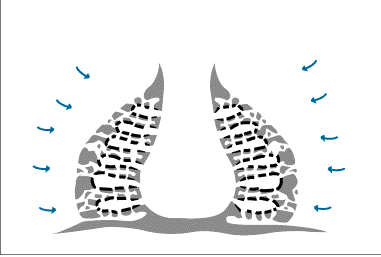



Sponges look like plants, but really they're immoble, primitive animals.
Incurrent and excurrent canals run parallel, conducting water inward to flagellated chambers.
Despite the wide variation in their overall appearance, from upright tubes to the look of melted ice cream on rocks, all sponges display the same basic body plan. Sponges, which lack a nervous system, mouth and gut, consist of collections of cells built around internal water canals.
These immobile animals wait for food to come to them. A sponge sweeps water through a network of canals while individual cells engulf the microscopic food particles brought by the currents.
Sponges get their phylum name, Porifera, meaning pore-bearer, from their tiny surface pores into which the currents flow. The inward currents coalesce as the internal canals merge, and finally the water, this time bearing sponge wastes, exits through the sponge's large visible openings. A sponge the size of a crayon pumps up to 20 liters of water each day through its body.




